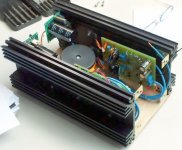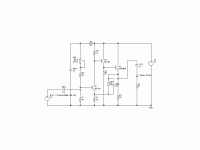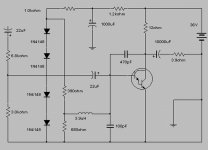Hi Cup of coffee,
I have a pot on, never a problem around here. You're welcome by!
If you use mosfets, they can be self limiting for current. So you have built in bias compensation. IR devices are effective at the higher dissipations like you have here. You will need larger everything simply due to the current and heat you are dissipating with these designs.
Hartono posted the links I was about to direct you to. Go visiting. Nelson might like coffee. His technicians certainly must (by definition).
Remember Cup of coffee, all technicians have this rule built in. .....
COFFEE.POT Not found.
Technician halted.

I have a pot on, never a problem around here. You're welcome by!
Well, of course!More coffee anyone?
If you use mosfets, they can be self limiting for current. So you have built in bias compensation. IR devices are effective at the higher dissipations like you have here. You will need larger everything simply due to the current and heat you are dissipating with these designs.
Hartono posted the links I was about to direct you to. Go visiting. Nelson might like coffee. His technicians certainly must (by definition).
Remember Cup of coffee, all technicians have this rule built in. .....
COFFEE.POT Not found.
Technician halted.
I want mine with whipped cream..also some Chantilly cream...a little of chocolate
will be nice too....no..no..no!.....do not use honey please.... sugar melaçus is better (that dark one, form sugar cane).
8 plates of aluminium.... they can be fins of a heatsink...the area of each one of those 9 square plates will need to be 10 by 10 centimeters (around 4 by 4 inches)... if one aluminium plate...the area needed will be 12 square centimeters.
I hope this helps to explain how big it need to be.
This continuous dissipates more than 30 watts, alike a soldering iron...normal, standard AB amplifiers produces much less power....not only people do not use full volume as the signal goes to average dissipation...not that continuous current..this makes heatsinks bigger.
The image shows a forum friend that made a Krell.... one of those heatsinks may work.
regards,
Carlos
will be nice too....no..no..no!.....do not use honey please.... sugar melaçus is better (that dark one, form sugar cane).
8 plates of aluminium.... they can be fins of a heatsink...the area of each one of those 9 square plates will need to be 10 by 10 centimeters (around 4 by 4 inches)... if one aluminium plate...the area needed will be 12 square centimeters.
I hope this helps to explain how big it need to be.
This continuous dissipates more than 30 watts, alike a soldering iron...normal, standard AB amplifiers produces much less power....not only people do not use full volume as the signal goes to average dissipation...not that continuous current..this makes heatsinks bigger.
The image shows a forum friend that made a Krell.... one of those heatsinks may work.
regards,
Carlos
Attachments
Hi, So, tell me....whats it like? Just had a quick glance, it says response is 100 hz up, does that mean no low bass. What are you feeding it, and what loudspeakers are you using?
its good pleasant sounding, sounds better than commercial amps I compared it to
does not sound better than highly refined tube amp, but than it cost 1/10th of it
i am sure JLH is better than this one, but for sure than yours too
the bass is there, its just a little rolled off, if you use bass boost, it makes it almost even
I am feeding it with jungson hdcd player moon harbour s2
no preamp required
i use various loudspeakers, see my page, drives them easily, but than I like highly efficient speakers
otherwise its infinitely stable, runs only slightly hot, I use good heatsinks, 0.7 amps is not much, but requires plenty of filtration, just like any good NP classA amp would
have fun
Hi
I think there is a lot to be said for simple amplifiers! There cannot be many simpler than a resistor loaded Class A. I've thought that the three-transistor Class A is as close as we can get to the old triode-pentode amplifier from valve days.
They didn't sound bad ...until you heard a .00x% amplifier of today's best.
Here's my offering. It's not the lowest distortion - about 3% at peak output. You might do better with better transistors (MJ21194?). The BD140 dissipates about 2.5W and needs a good heatsink of its own. The 2N3055 dissipates about 30W and needs a substantial heatsink.
The resistor dissipates about 50W and should be a 50W type on another substantial heatsink.
Like most class A designs, the lower the power, the lower the distortion. Compared with many "tinny" class B and D type IC circuits in today's mass market electronics, it'll probably be better than those.
The 47 ohm load for the BD140 might seem "cruel" to some. It's not for the BD140. It is intended to speed up the turn-off of the 2N3055. Without it, the input stage will clip (distort) under fast input edges. There is a penalty that the distortion is higher, but this circuit represents a balance between overall performance and simplicity.
If you want more watts, you should probably increase the heatsinks, and use higher power transistors (MJ21194) and substitute an MJE15033 for the BD140.
Otherwise if you want to restore your old design with two transistors and no feedback I can try another option based on your suggestion.
cheers
John
I think there is a lot to be said for simple amplifiers! There cannot be many simpler than a resistor loaded Class A. I've thought that the three-transistor Class A is as close as we can get to the old triode-pentode amplifier from valve days.
They didn't sound bad ...until you heard a .00x% amplifier of today's best.
Here's my offering. It's not the lowest distortion - about 3% at peak output. You might do better with better transistors (MJ21194?). The BD140 dissipates about 2.5W and needs a good heatsink of its own. The 2N3055 dissipates about 30W and needs a substantial heatsink.
The resistor dissipates about 50W and should be a 50W type on another substantial heatsink.
Like most class A designs, the lower the power, the lower the distortion. Compared with many "tinny" class B and D type IC circuits in today's mass market electronics, it'll probably be better than those.
The 47 ohm load for the BD140 might seem "cruel" to some. It's not for the BD140. It is intended to speed up the turn-off of the 2N3055. Without it, the input stage will clip (distort) under fast input edges. There is a penalty that the distortion is higher, but this circuit represents a balance between overall performance and simplicity.
If you want more watts, you should probably increase the heatsinks, and use higher power transistors (MJ21194) and substitute an MJE15033 for the BD140.
Otherwise if you want to restore your old design with two transistors and no feedback I can try another option based on your suggestion.
cheers
John
Attachments
Hello John Ellis...your circuit is better than the one i have shown.
So...dear Coffee.... John has offered a better option.
John Ellis amplifier is very sensitive, can drive full power (2.5 watts) and over a normal 8 ohms speaker..... will need a potentiometer in the input, as produces full power with 160 milivolts of signal in the input.
Very good.
regards,
Carlos
So...dear Coffee.... John has offered a better option.
John Ellis amplifier is very sensitive, can drive full power (2.5 watts) and over a normal 8 ohms speaker..... will need a potentiometer in the input, as produces full power with 160 milivolts of signal in the input.
Very good.
regards,
Carlos
Hi Cup of coffee,
Of course!
You have options. A direction is all you need now.
-Chris
Well, what do you think??Biscuit anyone?
Of course!
You have options. A direction is all you need now.
-Chris
I have designed and built a good sounding amp that operates nearly identical to your simple 2 trans circuit, voltage and current gain both from the output stage. Its a little more complicated than the others posted here but had a very stable operating point.
http://www.diyaudio.com/forums/showthread.php?s=&threadid=85793&perpage=10&pagenumber=9
see post 89
http://www.diyaudio.com/forums/showthread.php?s=&threadid=85793&perpage=10&pagenumber=9
see post 89
- Status
- This old topic is closed. If you want to reopen this topic, contact a moderator using the "Report Post" button.
- Home
- Amplifiers
- Solid State
- Where did I go wrong?



